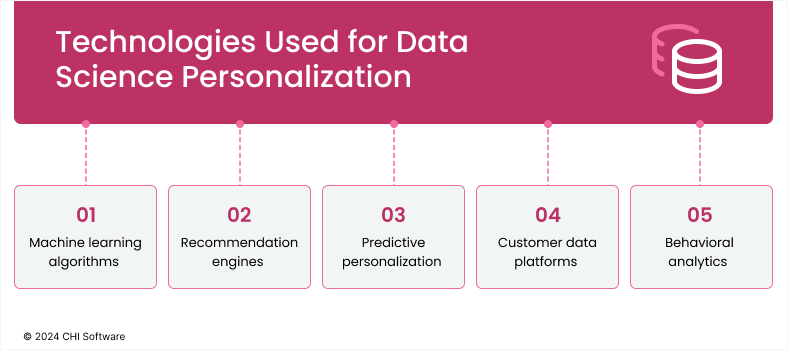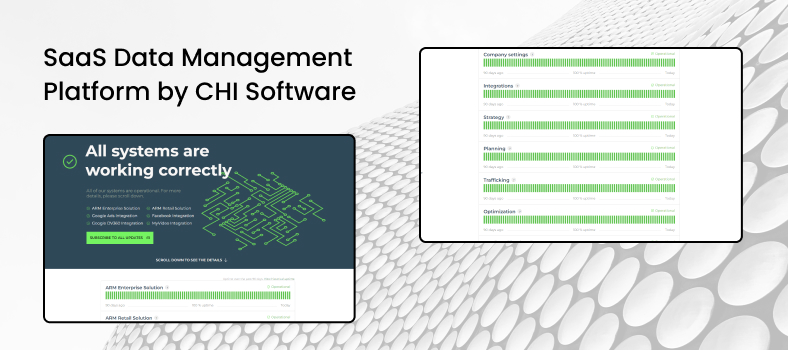Personalized customer experiences are the new norm. If you get it right, it can be very profitable – but you first need to know what your shoppers want to provide tailored experiences.
This is where data science plays a big role. Data science focuses on generating insights from data, it’s a no-brainer to use it for personalization. In this article, we will dive deeper into how exactly data science can help make tailored experiences for your customers into a reality.
Article highlights:
- The most popular and efficient technologies fueling data science personalization include machine learning, recommendation engines, predictive personalization, behavioral analytics, and customer data platforms;
- Beware of the challenge! Before starting a data science project, consider sensitive issues such as data privacy and accuracy, ethical concerns, and limitations of your technology infrastructure;
- Our practical case study shows that one of our clients, an adtech company, managed to significantly improve the targeting of their ad campaigns thanks to data-driven personalization.
Are Data Science and Personalization Connected?
Personalization is one of the biggest drivers of customer satisfaction and engagement. The logic is to analyze customer behavior and create tailored experiences based on it. But what makes it tick?
The short answer is data. The way that a customer makes their journey through a store to find what they’re looking for can be used to understand their needs and behaviors. While it can be done manually for a couple of in-store clients, it’s barely possible for businesses with large audiences, especially online, because there’s too much data — so what do you do?

This is where data science comes in: analyzing customer data, and drawing insights from it that can be turned into decisions. Data scientists structure and analyze data to see the logical patterns in it. These patterns lead to the understanding of trends, customer interests and needs. Such structuring often begins with data modeling services, which transform raw customer inputs into clear frameworks that make advanced personalization possible.
At the heart of personalization lies big data development, enabling companies to process massive datasets and deliver relevant user experiences in real time. The more information you have, the more value you can extract from it. There are a lot of ways to get insights into what customers like, so let’s talk about the most popular ones.
Data Science Personalization: Essential Technologies Explained
The variety of technologies for data-driven personalization is astonishing. Here, we will cover the most popular ones.

The most popular AI technologies that can boost your personalization activities.
Machine Learning (ML) Algorithms
With the rise of AI, new tech advancements pop up almost every day. One is machine learning algorithms. By applying AI’s ability to learn and analyze data, businesses can get valuable insights into customer’s behavior and preferences.
Four types of algorithms in particular work well for data-driven personalization:
- Clustering algorithms analyze unlabeled data and separate it into groups with similar traits. One of the most popular uses for clustering algorithms is recommendation engine development and anomaly detection;
- Regression analysis identifies relations between target data and independent variables, and is very useful for forecasting and trend prediction;
- Association rules uncover relationships between units of information in huge datasets. This allows for the creation and definition of relations between different users to determine how they relate to each other;
- Markov chains show a possible sequence of events based only on the current state of the process. Markov chains work best in combination with other ML algorithms.
Behind the scenes, data pipeline development ensures a continuous flow of information from raw sources to analytical models powering personalization.
Recommendation Engines
These tools gather customer data to provide suggestions for the most fitting items by constantly tracking user interactions, such as clicks and views, feeding the engine more and more data and allowing the tool to adapt to changes.
Recommendation engines can provide customers with new categories of products and more. For example, if the user abandons their cart, the engine can suggest items similar to the ones the customer abandoned.
Predictive Personalization
This approach is similar to using recommendation engines, but a little more complex. Predictive personalization uses data about a customer’s past behavior, such as what they’ve viewed or bought before, along with information from other similar users, to guess what they might want in the future.
For example, if a person often buys mystery novels, a website might suggest more mystery books to them. Or if a user watches a lot of action movies, a streaming service might recommend new action films the person hasn’t seen yet.
Customer Data Platforms (CDPs)
Customer Data Platforms (CDPs) are software systems that aggregate and manage customer data from a variety of sources:
- CRM systems;
- Transaction databases;
- Websites;
- Mobile apps.
The data collected is then used to create a full picture of the customer’s behavior and interests. A CDP analyzes this data and focuses on overlapping cases. Using Customer Data Platforms is a must if you want a complete portrait of each customer for tailored experiences.
To orchestrate all these moving parts effectively, companies often implement DataOps services that streamline integration, improve collaboration, and accelerate personalization delivery.
Behavioral Analytics
A big part of creating personalized experiences is to study customers’ behavior. This process involves:
- Data collection: Engineers need a wide range of complex data from users, including interactions with customer support and details about their journey through your services. When multiple systems are involved, ETL migration services help standardize data flows and ensure consistency across personalization models.
- Analytical methods: By leveraging machine learning and predictive modeling, behavioral analytics reveals hidden patterns and trends within the data.
- Actionable insights: Businesses receive valuable insights that can inform strategies, drive product development, and help understand customer preferences.
Data Science in the Cloud: How Cloud Computing Impacts Analytics
Read more
As you can see, there are several useful options to consider in terms of data science personalization. With the right combination of tools, you can achieve the customer engagement and satisfaction you need.
And we don’t just know theory — we have experience to refer to. Let’s open up our case studies portfolio and look at the application of data-driven personalization.
SaaS Data Management Platform: Personalized Recommendations for Ad Campaigns
Our client, an advertising technology company, wanted to optimize their processes and provide data-driven personalization and sought the help of our data management consultants to create a full-featured SaaS management platform that would meet their needs.
Out of all the features we developed, two stand out for how they utilized data science for personalization:
- Dashboards: We created dashboards to provide users with personalized insights on ad campaign performance. One of them focused on comparing a campaign’s performance with its goals, while the other compared forecasts to actual results;
- Recommendation system: Ad campaigns have targeted goals for each user. The advanced algorithms we create use customer data and preferences to provide recommendations on marketing campaigns, strategies, and budget optimization.
Other features we developed included:
- A dedicated monitoring page for client servers;
- An improved UI with customization options and a dedicated recommendation list;
- Process optimization for better usability.

A SaaS platform as a great solution for personalized marketing campaigns
The project is still ongoing; however, our client has already seen improvements:
- A 30% increase in operational speed;
- Improved quality of ad campaign planning;
- A 10% to 20% increase in return on investment.
We are excited to work on this solution. To learn more about it, you can read our extensive case study. In the meantime, let’s talk about other projects of ours.
Data Science Personalization: Challenges and Solutions
Despite data-driven personalization being a current trend, it’s not the easiest thing to implement. Let’s talk about the challenges you might encounter and how to solve them.

The best practices to solve popular challenges of data science personalization
Data Privacy
Problem: Any technology that uses customer data raises concerns about data privacy. While this data is very beneficial for businesses, malicious actors also see value in it.
Solution: To deal with privacy concerns, you need to provide sufficient data protection. Encrypt your data and have an access control system in place to divide who has access to which data. A good call would be to look into firewall software to protect yourself from data breaches.
Most importantly, strong data governance consulting helps companies balance personalization with compliance, protecting user trust while ensuring data quality.
Personalization vs Privacy: Balancing User Recommendations and Data Protection
Read more
Limitations of the Technology Infrastructure
Problem: To perform data science personalization, you need a lot of data to store. This data must be analyzed, too, which depends on how much computing power you have available.
Solution: One of the best solutions for data storage and analysis is to look into cloud services. This option is cheaper than maintaining your own servers and can provide you access to computing powers outside of your organization.
Companies moving personalization workloads to modern platforms often rely on data migration consulting to transfer critical datasets securely and prepare them for scalable cloud environments.
Data Accuracy and Relevance
Problem: Personalized experience technology is highly reliant on data quality. Insufficient data can result in inaccurate recommendations, which defeats the whole purpose of personalized experiences.
Solution: To ensure accurate and relevant responses, look into the quality of data you’re using. Here’s what our engineers recommend doing to maintain data quality:
- Gather data from reliable and relevant sources;
- Make sure the data is diverse, covering a wide range of scenarios, variations, and conditions;
- Increase diversity if needed by augmenting your data with data from other sources, for example, synthetic data;
- Clean your data by removing duplicates and correcting errors;
- Label your data carefully.
AI Personalization on the Rise: How to Set Up a Recommendation Engine
Read more
Ethical Concerns
Problem: The use of customer’s data without their knowledge can be considered to be intrusive. For this reason, some people might be reluctant or frustrated knowing their data will be used to create tailored experiences.
Solution: You must be transparent about how you use customer’s data. Use it only if shoppers explicitly give you their consent and provide a clear policy on how you will use their information.
Final Thoughts
Personalized customer experiences are the future for any industry that provides services or consumer goods. Data science helps to elevate this technology to the next level as more and more businesses live online.
We’ve just reviewed the most popular tech tools that make personalization possible even if your audience counts thousands of people. We also covered our practical experience and solutions to the most common challenges. But it’s only words on paper – let’s create something great to cover your goals and aspirations.
With a team of vetted data scientists, there’s hardly a peak you can’t conquer. But a journey of thousands miles starts with the first step, so here it is – leave us a message in this contact form, and whether it’s the very beginning of your project or you’re looking to add a couple of AI-based features, CHI Software is always here to offer our expertise.
FAQs
-
What types of businesses benefit the most from data-driven personalization?

Businesses of any size, big or small, that collect customer data can benefit from data-driven personalization. These are the industries that may notice the biggest difference:
- Retail and e-commerce;
- Media and entertainment;
- Travel and hospitality;
- FinTech;
- EdTech;
- Healthcare;
- Telecommunications.
-
Can small and medium-sized businesses (SMBs) afford data-driven personalization solutions?

While it may seem like personalized experiences are expensive, the reality is the opposite. By using tools and methods such as recommendation engines, CDPs, and behavioral analytics, you can get the same results as enterprise companies.
Another good call is to use cloud technologies to store and process data. A clever combination of free tools and more affordable technologies can bring data-driven personalization to your customers without a big investment.
-
How can I measure the success of my personalization efforts?

There are multiple metrics to determine the success of your personalization efforts. For example, you can compare conversion rates before and after data-driven personalization. Another good metric to look into is engagement and click-through rates (CTRs). We also recommend checking revenue impact, segment performance, and operational efficiency.
-
How long does it take to see results from data-driven personalization?

The answer depends on the strategy you chose and the quality of your data. Rough numbers vary on your goals; for example, to see short-term results, you may need up to three months, while long-term results will take more than six months.
-
Why should I choose CHI Software for my data-driven personalization needs?

We have experience implementing data-driven personalization technologies. At the same time, we are proficient in big data and data engineering, which are perfect tools to provide users with tailored experiences.
Our development approach is client-centric, meaning that while working on the project, we will constantly keep you updated. We also provide high levels of customization so that the software can evolve to meet your business needs.
Lastly, we are official partners with AWS and Microsoft, so storing and processing data won't be a problem if you work with us.
About the author
Alex is a Data Scientist & ML Engineer with an NLP specialization. He is passionate about AI-related technologies, fond of science, and participated in many international scientific conferences.
Rate this article
24 ratings, average: 4.5 out of 5






